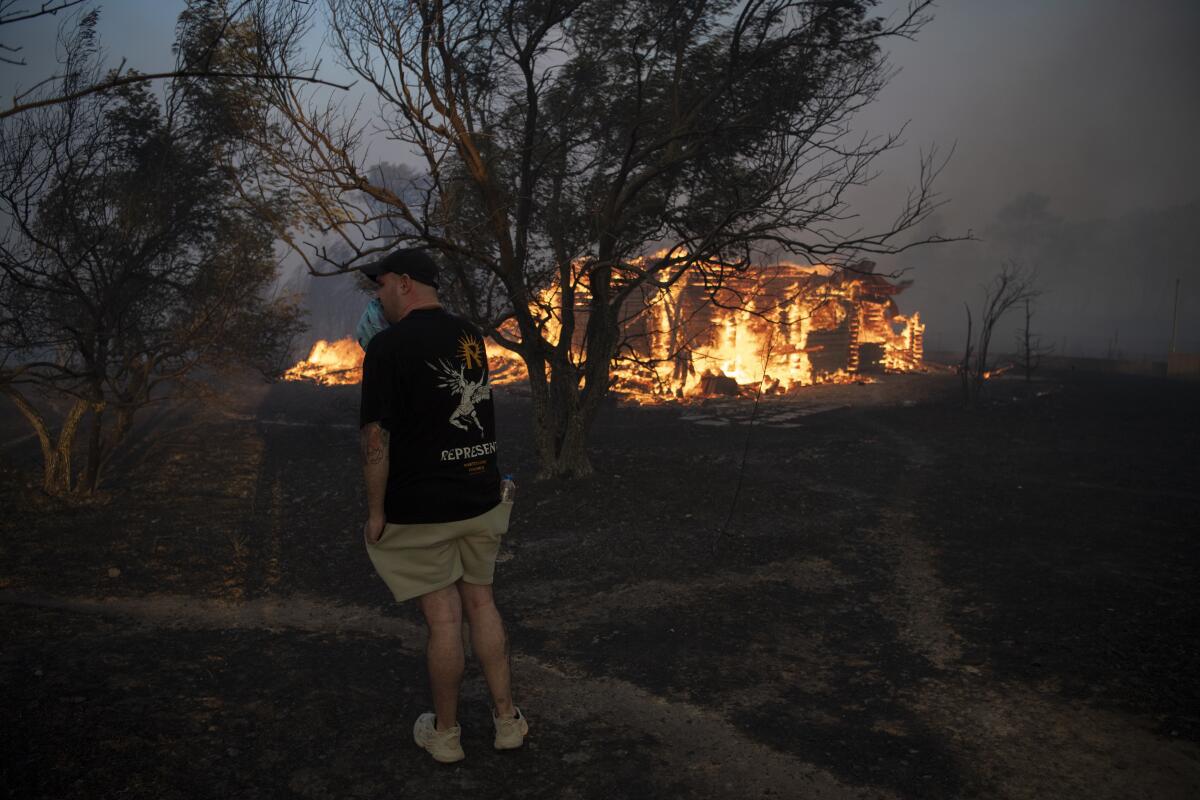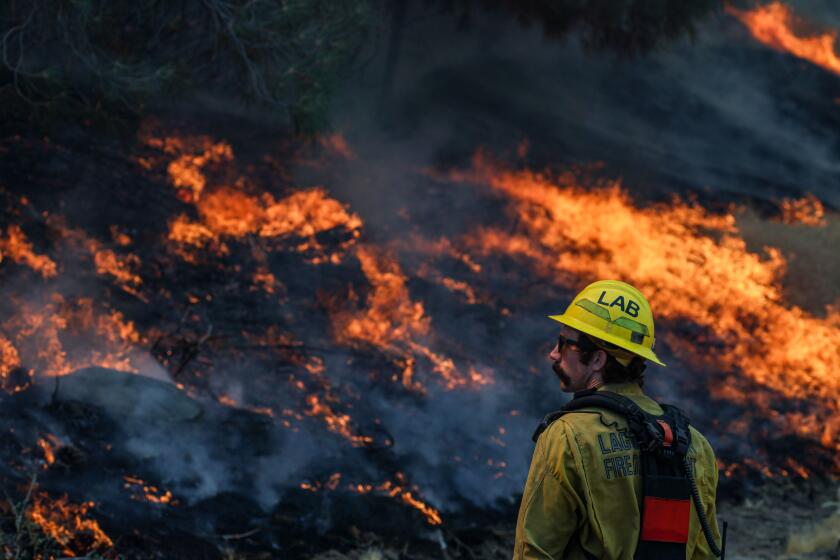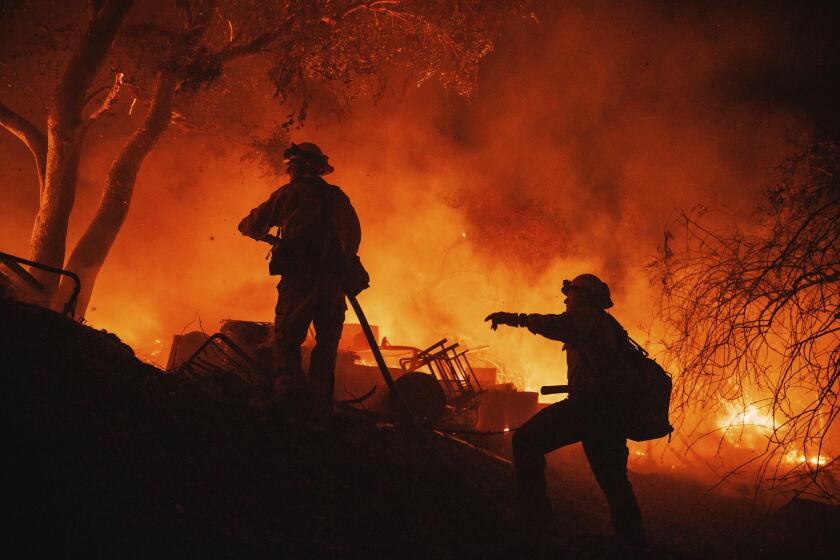Opinion: A summer of extreme heat and wildfire shows the cost of human folly

- Share via
As Greece attempts to recover from the recent destructive wildfires around Athens, Southern Californians facing our own heat wave should take note of the pattern that enabled them. It should be well-known by now: sprawl into the urban-wildland interface where development collides with nature, the corresponding replacement of grass, shrubs and other plants native to the area with many more trees for shade, then strain on the land thanks to drought, record high heat and wind, intensified by climate change. The conditions that led to the worst wildfires in Greece this year, burning 156 square miles, damaging more than 100 homes and causing at least one death, apply in Los Angeles too.
The Athens fires can be traced back to the 2004 Olympics. To prepare for the Games, Athens underwent major (and needed) public transportation and freeway improvements and built a new international airport on agricultural lands. Lax land use regulations, and an eager development community, led to significant building in suburban areas where flammable vegetation increased significantly over time. The flames that so fiercely threatened Athens this summer largely burned in this newly developed area. There were limited fire precautions, such efforts as eliminating trees or flammable plants next to houses, closing exposed overhangs on houses, or clustering homes to create defensible space around them.
For the record:
3:09 p.m. Sept. 6, 2024A previous version of this piece incorrectly stated that this year’s fires around Athens burned 156 square miles, equivalent to 24,700 acres. That is instead equivalent to almost 100,000 acres.
It’s not even the midpoint of summer in California and wildfires have already scorched more than 751,000 acres, straining firefighting resources, forcing evacuations and destroying homes.
Before this development, the area was, like most of the European southern Mediterranean, covered by vegetation comparable to the chaparral that has long characterized Southern California. Scrubby and dense, in France it is called garrigue or maquis and in Greece, phrygana. Now that it is no longer grazed by the sheep or goats once herded for their milk and meat, it’s seen as junk vegetation that should be replaced by trees, preferably pine.
But phrygana is far more adapted to fire and resistant to its worst potential than flammable pine forests. Not only has this shift reduced the protective diversity of vegetation, but it also disrupts fire as a controlled natural phenomenon that has long shaped and been shaped by indigenous vegetation.
Houses built in the heart of this landscape transformation are at risk of larger, uncontrolled fires — no different than in our own mountains here.
In our region, we have exacerbated the situation with counterproductive attempts at vegetation management that include bulldozing fire breaks — ribbons of land devoid of plants — that become hospitable to highly flammable weeds. We should be engaging in controlled burns and, for landscaping around homes, cultivating chaparral that has many species of plants that are not highly flammable. Instead, we pursue our ideas of aesthetic landscapes often centered on flammable trees, undervaluing the biodiverse, scrubby vegetation that is typically more climate- and fire-appropriate.
On a recent trip to southern France, traveling from Marseille to the Pyrenees, I encountered (amid a staggering amount of wine grapes) neatly planted rows of Aleppo pine snuggled up next to houses, where a mix of garrigue and trees used to be. Looking at it, all I could think was how much the landscape encourages devastating fires, especially with the rising heat (and boy was it hot), drought and wind. In Athens, Marseille and Los Angeles, sprawled-out housing increasingly facilitates this dangerous pattern.
As the globe overheats, Californians and others must shift our thinking about wildfire.
Trying to curb development in the periphery of places where housing is considered scarce — old urban centers such as Marseille or Athens — is tough. But such sprawl not only invites fire, it creates traffic problems, habitat fragmentation and spiraling infrastructure costs. In California and around the Mediterranean, few developments are denied for fire safety. Some developers and authorities build fire stations but without the resources to maintain them. They may claim that the road infrastructure will be fine for evacuations and that vegetation management will deter fire. There isn’t compelling evidence of such success so far. The only industry that seems to be concerned is insurers; companies have exited or restricted their participation in California’s homeowners insurance market because of our fire susceptibility.
How will we begin to address the simmering disaster of these conditions, which have grown exponentially over the past few decades? Even if it’s implemented immediately, climate policy won’t eliminate fire risk or fully bring down temperatures. Many houses have been built in the burnable periphery and humans keep finding ways to light fires, including, this summer, pushing a burning car down a gully, reportedly leading to the Park fire that has burned more than 400,000 acres. The Athens fire is believed to have started from a faulty power cable, similar to the Camp fire that burned more than 150,000 acres in California.
It is time to take a firmer stand not only against unchecked development in flammable areas, but against the pursuit of landscapes that contribute to fire risk. The diversity of vegetation indigenous to a place can support the need for controlled fires.
Some fire remains inevitable, especially as we face more hot days and drought with ever-higher temperatures. But we don’t have to court greater destruction via human folly. A new ethic is called for, one of acknowledging that the development and vegetation we find the most desirable are not always what’s best for the Earth and, therefore, for our survival.
Stephanie Pincetl is a professor at the UCLA Institute of the Environment and Sustainability.
More to Read
A cure for the common opinion
Get thought-provoking perspectives with our weekly newsletter.
You may occasionally receive promotional content from the Los Angeles Times.












